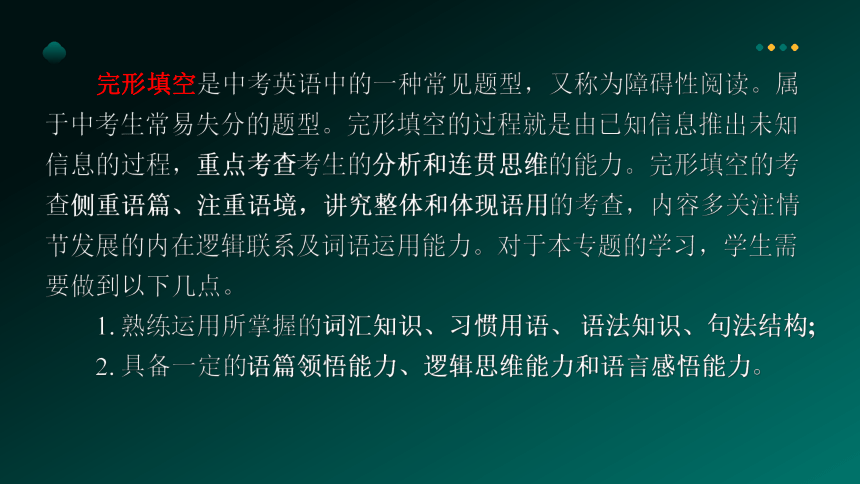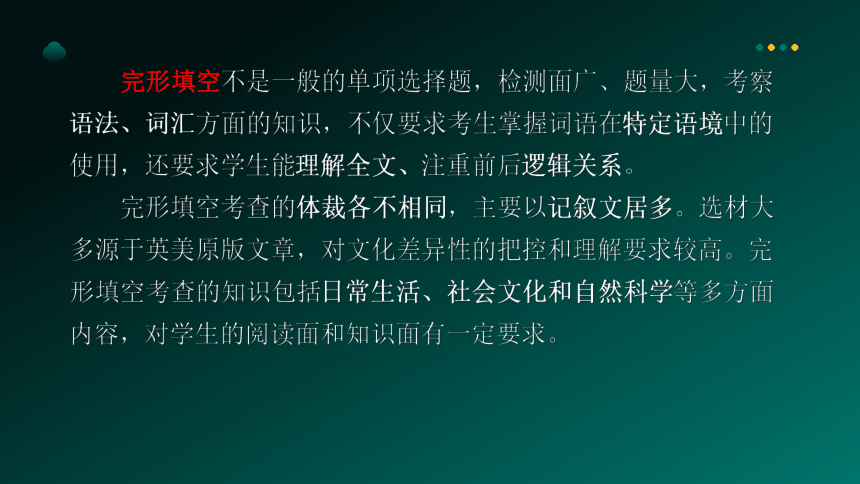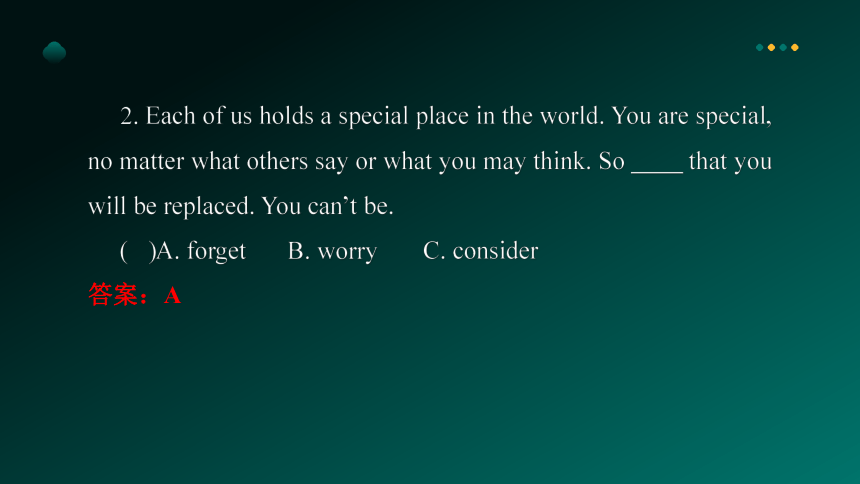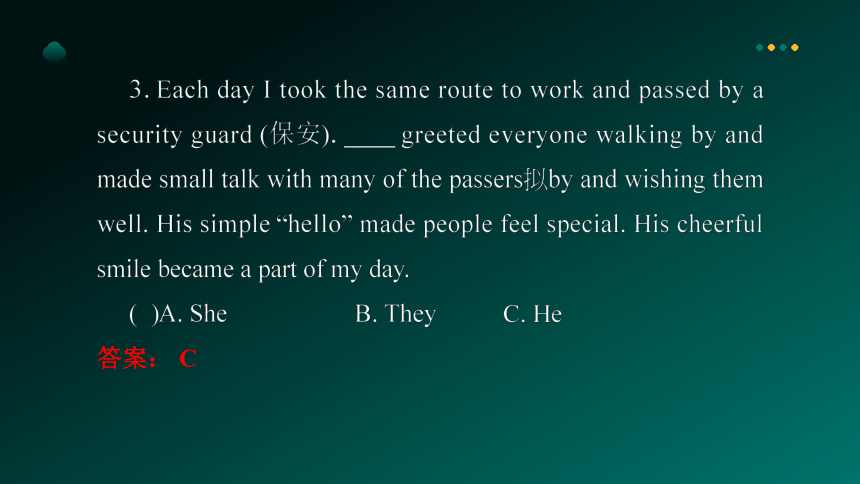2025年牛津译林版英语中考专题复习课件:课题二十 完形填空(共41张PPT)
文档属性
| 名称 | 2025年牛津译林版英语中考专题复习课件:课题二十 完形填空(共41张PPT) |  | |
| 格式 | pptx | ||
| 文件大小 | 1.5MB | ||
| 资源类型 | 教案 | ||
| 版本资源 | 牛津译林版 | ||
| 科目 | 英语 | ||
| 更新时间 | 2025-03-13 08:06:19 | ||
图片预览












文档简介
(共41张PPT)
2025年英语中考复习
课题二十 完形填空
专题复习
聚焦中考
壹
完形填空是中考英语中的一种常见题型,又称为障碍性阅读。属于中考生常易失分的题型。完形填空的过程就是由已知信息推出未知信息的过程,重点考查考生的分析和连贯思维的能力。完形填空的考查侧重语篇、注重语境,讲究整体和体现语用的考查,内容多关注情节发展的内在逻辑联系及词语运用能力。对于本专题的学习,学生需要做到以下几点。
1. 熟练运用所掌握的词汇知识、习惯用语、 语法知识、句法结构;
2. 具备一定的语篇领悟能力、逻辑思维能力和语言感悟能力。
核心知识点
贰
完形填空不是一般的单项选择题,检测面广、题量大,考察语法、词汇方面的知识,不仅要求考生掌握词语在特定语境中的使用,还要求学生能理解全文、注重前后逻辑关系。
完形填空考查的体裁各不相同,主要以记叙文居多。选材大多源于英美原版文章,对文化差异性的把控和理解要求较高。完形填空考查的知识包括日常生活、社会文化和自然科学等多方面内容,对学生的阅读面和知识面有一定要求。
完形填空题的话题贴近学生生活,立意积极向上,融入对考生情感态度和价值观的正向引导,考生答题过程就是一次潜移默化地接受人文熏陶的过程。
完形填空一般不给标题,但有主题句,主题句往往是在文章的开头或结尾,主题句是了解文章的关键,抓住主题句,就能更好地了解文章大意。
在语言层面上,完形填空题所选素材的语言比较地道、真实,一般没有复杂的语言和生僻的表达方式,题目设计目的是在语篇层面考查学生准确使用语言的能力。
●易错点
一篇文章传达的是作者的观点、思想情感和意图。做题时不能把自己的观点想当然地代入,一定要在文章本身的语境中去理解和思考。
考点攻坚
叁
考点1 语境推断,找出人物、事件和情感态度(必考)
解答语境推断题时,应根据上下文的提示或暗示,身临其境地体验作者的情感态度,再推断出符合语境的最佳选项。
●通关必练
1. Several weeks ago, our headmaster, Mr.Gaudi, told us that our school had been chosen to compete on Smart Aleck—a game show which my best friend Carla and I both love. Carla has a good imagination, and I know a lot of history, so we thought we’d be good for the team.
( )A. choices B. pairs C. leaders
答案:A
2. Each of us holds a special place in the world. You are special, no matter what others say or what you may think. So that you will be replaced. You can’t be.
( )A. forget B. worry C. consider
答案:A
3. Each day I took the same route to work and passed by a security guard (保安). greeted everyone walking by and made small talk with many of the passers?by and wishing them well. His simple “hello” made people feel special. His cheerful smile became a part of my day.
( )A. She B. They C. He
答案: C
4. Soon after, the company sent me a book about the life of Thomas Edison. How I enjoyed reading and re-reading about his ! I like the recorded sound and the electric light most.
A. projects B. suggestions C. inventions
答案:C
考点2 利用前后暗示,找出词汇复现的词(常考)
暗示分前后两种。下文的填空答案可从上文中找到叫前暗示,上文的填空答案可从下文中找到叫后暗示。也就是说,前面的空项从当时的情况来看,或是线索不清,或是语境不明,可能暂时无法填出,但只要考生继续往下读,就会发现此空在后面的某个地方有关于答案的暗示。
●通关必练
1. Later, we found a model plane in a store. I learned that different inventors often invent similar things.
( )A. different B. similar C. large
答案: B
2. It was last June. I entered a supermarket to pick some vegetables, when a young man asked me, “Can you tell me where the counter(柜台)is ”
“Well, the milk is in the lower right corner,” I replied.
( )A. vegetable B. milk C. bread
答案: B
3. The next day at school, Paul didn’t hand in his homework and a test. Mrs.Green, his teacher, asked him to stay after school. “Paul, you didn’t do your homework. You didn’t pass the test and only got a D. This isn’t like you. What’s wrong ”
( )A. made B. missed C. failed
答案:C
4. By the end of his first week, David was at the bottom of our school’s social ladder. “It’s his own fault,” I told my mother one evening at dinner. “He even knows how to count.”
( )A. quickly B. suddenly C. hardly
答案:C
5. When I was 16, I took a part-time job for the first time in my life. I worked at a restaurant near my home for a whole . The month soon came to an end.
( )A. year B. month C. week
答案:B
考点3 固定搭配
固定搭配需要结合语境并利用常用句型及习惯表达来选择答案。因此,平时多积累动词短语、介词短语和固定句型是非常有必要的。
1. The dancers hard to perform like a real lion. Their “lion” may shake its body. The dance can be funny.
( )A. fight B. catch C. try
答案:C
2. Last Tuesday, I went to school for an English test. my way to school, I saw a woman lying on the ground.
( )A. In B. To C. On
答案:C
3. She had walking, playing with other children, and going to school.
( )A. trouble B. success C. trust
答案:A
4. I even found myself my mum with the dinner dishes and cleaning.
( )A. teaching B. taking C. helping
答案:C
考点4 利用上下文进行逻辑推理
逻辑推理法是做完形填空题时十分重要的方法之一。完形填空是一篇内容完整的文章,各行各段之间有着逻辑上的必然联系。因此可以在掌握全文主旨大意的前提下,通过对故事的线索、内容之间的逻辑关系及人物情感的发展等进行分析和理解,选出答案。
●通关必练
1. “My family was poor. My mother died when I was 14. I’ve lived with my father since...In the past, women were not allowed to play the opera, my father never stopped me when I tried to sing,” Qu said. And it gave her the chance to start a journey with the opera.
( )A. or B. because C. but
答案:C
2. I had to make a decision: should I move on and go to school for the test help the woman in need
( )A. or B. as C. and
答案:A
3. The main character of the film is still Buck, a big house dog. , this time, Buck is a 100 percent character created by 3D technology.
( )A. Although B. So C. However
答案:C
4. When Paul got home, he his dad. But there was no answer. Then it went to voicemail(语音信箱). Paul began talking, “Dad, I can’t play with you next weekend. I’ve got lots of problems with my homework. Also, I really don’t want to spend another day looking out of the window and waiting. Whenever you our plans, Dad, it hurts me. It’s not too late to rebuild our relationship, but we have to start small.”
( )A. saw B. thanked C. called
( )A. prepare B. break C. follow
答案:C B
5. As Paul ended the call, he felt much relaxed. He didn’t know whether his dad would be different, but it didn’t matter. He himself. He expressed his feelings to the right person. He had a clear head as he was doing his homework that evening.
( )A. complained B. insisted C. changed
答案:C
【注意】:有些过渡词语在文章中起着承上启下的作用,不可忽视。例如:
表示强调in a word、in my eyes、indeed、certainly
表示对比on the other hand、although、though、while
连词but、or、and
部分人称代词it、she、he、we、they
表示作者态度must、should、have to、I’d like to、you’d better
表示否定意义nothing、hardly、never、few、little
表示次序at first、at last、then、next
有些词看起来微不足道,但由于有衔接功能,能表明句与句之间的语义关系,其作用是不可低估的。这些词主要有:
表示并列关系:and、while...
表示转折关系:but、however、though、whereas、yet、otherwise、nevertheless...
表示顺序关系:before、after、then、finally...
表示让步关系:although、despite...
表示因果关系:so、thus、for...
表示解释关系:that is to say...
表示条件关系:if、in case...
表示递进关系:moreover、besides、furthermore、what’s more、in addition to、as well as...
靶向突破
肆
A篇 (2024·河南)(记叙文)
My name is Daniel. I live in Tennessee. When I was 7, I found some plastic (塑料的) bottles on a riverbank. I felt worried because I knew plastic bottles and other rubbish could be 1 to animals in rivers. Now I’m 13, and I work to keep rubbish out of rivers.
The Tennessee River is 2 polluted with plastics and other rubbish. And I want to do something to help stop more 3 . I do some 4 cleanups with others. We go along the riverbanks. Sometimes we go to places that we can only reach by boat. We often find plenty of 5 , such as broken toys and plastic bags.
Doing cleanups makes me really 6 . I know I’m making a difference and 7 lives—not just animal lives, but human lives as well, because it continues up the food chain (链条). What happens to them happens to us.
真金火炼
Last year, I set up the Cleanup Kids with my friends to call on kids all around the world to 8 rubbish. People take pictures of the rubbish 9 send them to us, so we can know how many pieces they found. We will 10 our goal (目标) of 1,000,000 pieces at the end of this month.We’re never too young to change the world. Kids area small part of the population, but we are 100% of the future.
( )1. A. good B. helpful C. harmful
( )2. A. badly B. hardly C. carefully
( )3. A. invention B. pollution C. attention
( )4. A. sea B. lake C. river
( )5. A. rubbish B. fruit C. fish
( )6. A. nervous B. bored C. happy
( )7. A. studying B. saving C. creating
( )8. A. pickup B. look after C. throw away
( )9. A. or B. and C. but
( )10. A. find B. set C. hit
C
A
B
C
A
C
B
A
B
C
B篇 (2023·安徽)(记叙文)
Lisa works in the dining hall of a primary school. Her job is to serve breakfast and lunch to teachers and 1 .
Because Lisa has a hearing problem, the students weren’t able to 2 with her effectively (有效地). They just pointed to the 3 they wanted. This year, however, things have changed a lot. It all started with Betty, a new teacher at the school.
Betty has learned sign language (手语) 4 three years. One day, she started a conversation in sign language with Lisa in the dining hall. The students there stopped eating and 5 the sign language conversation with interest.
The next day, Betty asked 6 students, “Would you like to learn how to 7 your hands to ‘talk’ to Lisa ” Everyone in the class said yes. She then began teaching the students some 8 sign language to say hello and how to order food.
The head teacher of the school heard about this. 9 he decided that the whole school should learn some sign language. Now, all the people at the school are learning sign language 10 . And Lisa is feeling so loved at work!
( )1. A. students B. parents C. cooks
( )2. A. work B. check C. communicate
( )3. A. chalk B. food C. money
( )4. A. after B. of C. for
( )5. A. watched B. guided C. finished
( )6. A. my B. your C. her
( )7. A. pull B. use C. wash
( )8. A. easy B. noisy C. sweet
( )9. A. Or B. And C. But
( )10. A. early B. angrily C. actively
A
C
B
C
A
C
B
A
B
C
C篇 (2022·大连)(记叙文)
Can you imagine a “xiao sheng”(young man role) is played by an 80-year-old woman That’s what Qu Juanru does. She is a(an) 1 and the official inheritor(继承人) of Jiaxing City’s Tongxiang flower-drum opera(花鼓戏). This kind of art 2 the daily life in the ancient water town and the traditional cultures of southern China.
Qu Juanru’s life with opera was not 3 . “My family was poor. My mother died when I was 14. I’ve lived with my father since. In the past,women were not allowed to play the opera, 4 my father never stopped me when I tried to sing,” Qu said. And it gave her the 5 to start a journey with the opera.
( )1. A. actress B. teacher C. doctor D. driver
( )2. A. runs B. shows C. starts D. prints
( )3. A. easy B. active C. cool D. boring
( )4. A. or B. because C. but D. so
( )5. A. mistake B. holiday C. question D. chance
A
B
A
C
D
At the age of 18,Qu joined a local troupe(戏班). Later,the troupe was broken up,and she went back to farming. After that,she 6 to bring the opera troupe back to life. 7 the troupe closed down again. Then she worked in a factory.
All of that changed in 2001. An officer from Wuzhen Tourism Center invited her back to the show. Knowing that,she was very 8 and agreed. Whether it is burning hot or freezing cold,she plays the opera for 3 hours every day. Even though Qu got a serious illness in 2017,she didn’t 9 . She gives her everything to the art. “I can still sing and act. I’d love to be here,as long as the people and the troupe 10 me,” Qu said.
Perhaps Qu sees her opera life as a wonderful dream.
( )6. A. refused B. managed C. regretted D. forgot
( )7. A. Generally B. Recently C. Sadly D. Hopefully
( )8. A. excited B. worried C. relaxed D. lonely
( )9. A. go on B. sit down C. give up D. show up
( )10. A. treat B. change C. control D. need
B
C
A
C
D
D篇 (2024·云南)(记叙文)
Once upon a time, there was a man who had four sons. One day, he told 1 of his sons to go and see what a pear tree looked like during winter, spring, summer and autumn. Although the sons felt strange about their father’s 2 , they went to see the pear tree. After a 3 , the father got them to come together and asked them what they had seen.The first son answered that the tree had been bare (光秃秃的) and 4 . The second son said, “No! It was covered with new 5 leaves. The tree had bright hopes.”
The third son 6 his head, and said, “No! The pear tree was full off lowers. They smelled so sweet and 7 so beautiful.”
“There were many pears 8 no flowers on the tree,” the fourth son disagreed, “I saw the joy of a good harvest (丰收). ”
The man then said to his sons that they were all right. They got 9 answers because each of them had seen only one season in the life of the pear tree.
“You cannot judge (评判) a tree, a person or your life byjust one season. If you 10 in your winter, you will miss the hope of your spring, the beauty of your summer and the harvest of your autumn.”
( )1. A. each B. both C. none
( )2. A. invitation B. request C. opinion
( )3. A. week B. month C. year
( )4. A. ugly B. lively C. tall
( )5. A. yellow B. green C. white
( )6. A. nodded B. raised C. shook
( )7. A. looked B. touched C. tasted
( )8. A. or B. but C. so
( )9. A. similar B. perfect C. different
( )10. A. give up B. look up C. Cheer up
A
B
C
A
B
C
A
B
C
A
E篇 (2022·广州)(说明文)
Some artists are often not famous during their lifetime. Vincent van Gogh (凡·高) was such an artist. People did not pay much attention to his 1 . He began to think he was nota very good painter. But he did not give up painting. He was so 2 in what he was painting that he did not want to stop. He would even 3 to eat!
4 , his paintings were dark. He used pencils or charcoal sticks (炭条) to make them. Then he 5 color. He used lots of brown and dark green.
Later, Vincent moved to France. He wanted to learn from the artists who 6 there. They were trying new 7 of painting. In France, Vincent began using bright colors. He used oil paints (油画颜料) to create his art. He painted both the countryside and people. He 8 painted self-portraits (自画像). He created more than 20 portraits of himself!
Vincent completed more than 2,000 paintings in his life. 9 people did not buy his paintings during his lifetime, his paintings sell for a lot of money today. People think his paintings are masterpieces (杰作). For example, the painting Sunflowers is very 10 all over the world.
( )1. A. trips B. paintings C. villages
( )2. A. wrong B. lucky C. interested
( )3. A. forget B. start C. hope
( )4. A. At first B. Once again C. At least
( )5. A. helped B. added C. missed
( )6. A. worked B. sang C. danced
( )7. A. facts B. stories C. ways
( )8. A. never B. hardly C. also
( )9. A. Before B. Though C. If
( )10. A. humorous B. polite C. famous
B
C
A
A
B
A
C
C
B
C
知 识 梳 理
巩 固 训
2025年英语中考复习
课题二十 完形填空
专题复习
聚焦中考
壹
完形填空是中考英语中的一种常见题型,又称为障碍性阅读。属于中考生常易失分的题型。完形填空的过程就是由已知信息推出未知信息的过程,重点考查考生的分析和连贯思维的能力。完形填空的考查侧重语篇、注重语境,讲究整体和体现语用的考查,内容多关注情节发展的内在逻辑联系及词语运用能力。对于本专题的学习,学生需要做到以下几点。
1. 熟练运用所掌握的词汇知识、习惯用语、 语法知识、句法结构;
2. 具备一定的语篇领悟能力、逻辑思维能力和语言感悟能力。
核心知识点
贰
完形填空不是一般的单项选择题,检测面广、题量大,考察语法、词汇方面的知识,不仅要求考生掌握词语在特定语境中的使用,还要求学生能理解全文、注重前后逻辑关系。
完形填空考查的体裁各不相同,主要以记叙文居多。选材大多源于英美原版文章,对文化差异性的把控和理解要求较高。完形填空考查的知识包括日常生活、社会文化和自然科学等多方面内容,对学生的阅读面和知识面有一定要求。
完形填空题的话题贴近学生生活,立意积极向上,融入对考生情感态度和价值观的正向引导,考生答题过程就是一次潜移默化地接受人文熏陶的过程。
完形填空一般不给标题,但有主题句,主题句往往是在文章的开头或结尾,主题句是了解文章的关键,抓住主题句,就能更好地了解文章大意。
在语言层面上,完形填空题所选素材的语言比较地道、真实,一般没有复杂的语言和生僻的表达方式,题目设计目的是在语篇层面考查学生准确使用语言的能力。
●易错点
一篇文章传达的是作者的观点、思想情感和意图。做题时不能把自己的观点想当然地代入,一定要在文章本身的语境中去理解和思考。
考点攻坚
叁
考点1 语境推断,找出人物、事件和情感态度(必考)
解答语境推断题时,应根据上下文的提示或暗示,身临其境地体验作者的情感态度,再推断出符合语境的最佳选项。
●通关必练
1. Several weeks ago, our headmaster, Mr.Gaudi, told us that our school had been chosen to compete on Smart Aleck—a game show which my best friend Carla and I both love. Carla has a good imagination, and I know a lot of history, so we thought we’d be good for the team.
( )A. choices B. pairs C. leaders
答案:A
2. Each of us holds a special place in the world. You are special, no matter what others say or what you may think. So that you will be replaced. You can’t be.
( )A. forget B. worry C. consider
答案:A
3. Each day I took the same route to work and passed by a security guard (保安). greeted everyone walking by and made small talk with many of the passers?by and wishing them well. His simple “hello” made people feel special. His cheerful smile became a part of my day.
( )A. She B. They C. He
答案: C
4. Soon after, the company sent me a book about the life of Thomas Edison. How I enjoyed reading and re-reading about his ! I like the recorded sound and the electric light most.
A. projects B. suggestions C. inventions
答案:C
考点2 利用前后暗示,找出词汇复现的词(常考)
暗示分前后两种。下文的填空答案可从上文中找到叫前暗示,上文的填空答案可从下文中找到叫后暗示。也就是说,前面的空项从当时的情况来看,或是线索不清,或是语境不明,可能暂时无法填出,但只要考生继续往下读,就会发现此空在后面的某个地方有关于答案的暗示。
●通关必练
1. Later, we found a model plane in a store. I learned that different inventors often invent similar things.
( )A. different B. similar C. large
答案: B
2. It was last June. I entered a supermarket to pick some vegetables, when a young man asked me, “Can you tell me where the counter(柜台)is ”
“Well, the milk is in the lower right corner,” I replied.
( )A. vegetable B. milk C. bread
答案: B
3. The next day at school, Paul didn’t hand in his homework and a test. Mrs.Green, his teacher, asked him to stay after school. “Paul, you didn’t do your homework. You didn’t pass the test and only got a D. This isn’t like you. What’s wrong ”
( )A. made B. missed C. failed
答案:C
4. By the end of his first week, David was at the bottom of our school’s social ladder. “It’s his own fault,” I told my mother one evening at dinner. “He even knows how to count.”
( )A. quickly B. suddenly C. hardly
答案:C
5. When I was 16, I took a part-time job for the first time in my life. I worked at a restaurant near my home for a whole . The month soon came to an end.
( )A. year B. month C. week
答案:B
考点3 固定搭配
固定搭配需要结合语境并利用常用句型及习惯表达来选择答案。因此,平时多积累动词短语、介词短语和固定句型是非常有必要的。
1. The dancers hard to perform like a real lion. Their “lion” may shake its body. The dance can be funny.
( )A. fight B. catch C. try
答案:C
2. Last Tuesday, I went to school for an English test. my way to school, I saw a woman lying on the ground.
( )A. In B. To C. On
答案:C
3. She had walking, playing with other children, and going to school.
( )A. trouble B. success C. trust
答案:A
4. I even found myself my mum with the dinner dishes and cleaning.
( )A. teaching B. taking C. helping
答案:C
考点4 利用上下文进行逻辑推理
逻辑推理法是做完形填空题时十分重要的方法之一。完形填空是一篇内容完整的文章,各行各段之间有着逻辑上的必然联系。因此可以在掌握全文主旨大意的前提下,通过对故事的线索、内容之间的逻辑关系及人物情感的发展等进行分析和理解,选出答案。
●通关必练
1. “My family was poor. My mother died when I was 14. I’ve lived with my father since...In the past, women were not allowed to play the opera, my father never stopped me when I tried to sing,” Qu said. And it gave her the chance to start a journey with the opera.
( )A. or B. because C. but
答案:C
2. I had to make a decision: should I move on and go to school for the test help the woman in need
( )A. or B. as C. and
答案:A
3. The main character of the film is still Buck, a big house dog. , this time, Buck is a 100 percent character created by 3D technology.
( )A. Although B. So C. However
答案:C
4. When Paul got home, he his dad. But there was no answer. Then it went to voicemail(语音信箱). Paul began talking, “Dad, I can’t play with you next weekend. I’ve got lots of problems with my homework. Also, I really don’t want to spend another day looking out of the window and waiting. Whenever you our plans, Dad, it hurts me. It’s not too late to rebuild our relationship, but we have to start small.”
( )A. saw B. thanked C. called
( )A. prepare B. break C. follow
答案:C B
5. As Paul ended the call, he felt much relaxed. He didn’t know whether his dad would be different, but it didn’t matter. He himself. He expressed his feelings to the right person. He had a clear head as he was doing his homework that evening.
( )A. complained B. insisted C. changed
答案:C
【注意】:有些过渡词语在文章中起着承上启下的作用,不可忽视。例如:
表示强调in a word、in my eyes、indeed、certainly
表示对比on the other hand、although、though、while
连词but、or、and
部分人称代词it、she、he、we、they
表示作者态度must、should、have to、I’d like to、you’d better
表示否定意义nothing、hardly、never、few、little
表示次序at first、at last、then、next
有些词看起来微不足道,但由于有衔接功能,能表明句与句之间的语义关系,其作用是不可低估的。这些词主要有:
表示并列关系:and、while...
表示转折关系:but、however、though、whereas、yet、otherwise、nevertheless...
表示顺序关系:before、after、then、finally...
表示让步关系:although、despite...
表示因果关系:so、thus、for...
表示解释关系:that is to say...
表示条件关系:if、in case...
表示递进关系:moreover、besides、furthermore、what’s more、in addition to、as well as...
靶向突破
肆
A篇 (2024·河南)(记叙文)
My name is Daniel. I live in Tennessee. When I was 7, I found some plastic (塑料的) bottles on a riverbank. I felt worried because I knew plastic bottles and other rubbish could be 1 to animals in rivers. Now I’m 13, and I work to keep rubbish out of rivers.
The Tennessee River is 2 polluted with plastics and other rubbish. And I want to do something to help stop more 3 . I do some 4 cleanups with others. We go along the riverbanks. Sometimes we go to places that we can only reach by boat. We often find plenty of 5 , such as broken toys and plastic bags.
Doing cleanups makes me really 6 . I know I’m making a difference and 7 lives—not just animal lives, but human lives as well, because it continues up the food chain (链条). What happens to them happens to us.
真金火炼
Last year, I set up the Cleanup Kids with my friends to call on kids all around the world to 8 rubbish. People take pictures of the rubbish 9 send them to us, so we can know how many pieces they found. We will 10 our goal (目标) of 1,000,000 pieces at the end of this month.We’re never too young to change the world. Kids area small part of the population, but we are 100% of the future.
( )1. A. good B. helpful C. harmful
( )2. A. badly B. hardly C. carefully
( )3. A. invention B. pollution C. attention
( )4. A. sea B. lake C. river
( )5. A. rubbish B. fruit C. fish
( )6. A. nervous B. bored C. happy
( )7. A. studying B. saving C. creating
( )8. A. pickup B. look after C. throw away
( )9. A. or B. and C. but
( )10. A. find B. set C. hit
C
A
B
C
A
C
B
A
B
C
B篇 (2023·安徽)(记叙文)
Lisa works in the dining hall of a primary school. Her job is to serve breakfast and lunch to teachers and 1 .
Because Lisa has a hearing problem, the students weren’t able to 2 with her effectively (有效地). They just pointed to the 3 they wanted. This year, however, things have changed a lot. It all started with Betty, a new teacher at the school.
Betty has learned sign language (手语) 4 three years. One day, she started a conversation in sign language with Lisa in the dining hall. The students there stopped eating and 5 the sign language conversation with interest.
The next day, Betty asked 6 students, “Would you like to learn how to 7 your hands to ‘talk’ to Lisa ” Everyone in the class said yes. She then began teaching the students some 8 sign language to say hello and how to order food.
The head teacher of the school heard about this. 9 he decided that the whole school should learn some sign language. Now, all the people at the school are learning sign language 10 . And Lisa is feeling so loved at work!
( )1. A. students B. parents C. cooks
( )2. A. work B. check C. communicate
( )3. A. chalk B. food C. money
( )4. A. after B. of C. for
( )5. A. watched B. guided C. finished
( )6. A. my B. your C. her
( )7. A. pull B. use C. wash
( )8. A. easy B. noisy C. sweet
( )9. A. Or B. And C. But
( )10. A. early B. angrily C. actively
A
C
B
C
A
C
B
A
B
C
C篇 (2022·大连)(记叙文)
Can you imagine a “xiao sheng”(young man role) is played by an 80-year-old woman That’s what Qu Juanru does. She is a(an) 1 and the official inheritor(继承人) of Jiaxing City’s Tongxiang flower-drum opera(花鼓戏). This kind of art 2 the daily life in the ancient water town and the traditional cultures of southern China.
Qu Juanru’s life with opera was not 3 . “My family was poor. My mother died when I was 14. I’ve lived with my father since. In the past,women were not allowed to play the opera, 4 my father never stopped me when I tried to sing,” Qu said. And it gave her the 5 to start a journey with the opera.
( )1. A. actress B. teacher C. doctor D. driver
( )2. A. runs B. shows C. starts D. prints
( )3. A. easy B. active C. cool D. boring
( )4. A. or B. because C. but D. so
( )5. A. mistake B. holiday C. question D. chance
A
B
A
C
D
At the age of 18,Qu joined a local troupe(戏班). Later,the troupe was broken up,and she went back to farming. After that,she 6 to bring the opera troupe back to life. 7 the troupe closed down again. Then she worked in a factory.
All of that changed in 2001. An officer from Wuzhen Tourism Center invited her back to the show. Knowing that,she was very 8 and agreed. Whether it is burning hot or freezing cold,she plays the opera for 3 hours every day. Even though Qu got a serious illness in 2017,she didn’t 9 . She gives her everything to the art. “I can still sing and act. I’d love to be here,as long as the people and the troupe 10 me,” Qu said.
Perhaps Qu sees her opera life as a wonderful dream.
( )6. A. refused B. managed C. regretted D. forgot
( )7. A. Generally B. Recently C. Sadly D. Hopefully
( )8. A. excited B. worried C. relaxed D. lonely
( )9. A. go on B. sit down C. give up D. show up
( )10. A. treat B. change C. control D. need
B
C
A
C
D
D篇 (2024·云南)(记叙文)
Once upon a time, there was a man who had four sons. One day, he told 1 of his sons to go and see what a pear tree looked like during winter, spring, summer and autumn. Although the sons felt strange about their father’s 2 , they went to see the pear tree. After a 3 , the father got them to come together and asked them what they had seen.The first son answered that the tree had been bare (光秃秃的) and 4 . The second son said, “No! It was covered with new 5 leaves. The tree had bright hopes.”
The third son 6 his head, and said, “No! The pear tree was full off lowers. They smelled so sweet and 7 so beautiful.”
“There were many pears 8 no flowers on the tree,” the fourth son disagreed, “I saw the joy of a good harvest (丰收). ”
The man then said to his sons that they were all right. They got 9 answers because each of them had seen only one season in the life of the pear tree.
“You cannot judge (评判) a tree, a person or your life byjust one season. If you 10 in your winter, you will miss the hope of your spring, the beauty of your summer and the harvest of your autumn.”
( )1. A. each B. both C. none
( )2. A. invitation B. request C. opinion
( )3. A. week B. month C. year
( )4. A. ugly B. lively C. tall
( )5. A. yellow B. green C. white
( )6. A. nodded B. raised C. shook
( )7. A. looked B. touched C. tasted
( )8. A. or B. but C. so
( )9. A. similar B. perfect C. different
( )10. A. give up B. look up C. Cheer up
A
B
C
A
B
C
A
B
C
A
E篇 (2022·广州)(说明文)
Some artists are often not famous during their lifetime. Vincent van Gogh (凡·高) was such an artist. People did not pay much attention to his 1 . He began to think he was nota very good painter. But he did not give up painting. He was so 2 in what he was painting that he did not want to stop. He would even 3 to eat!
4 , his paintings were dark. He used pencils or charcoal sticks (炭条) to make them. Then he 5 color. He used lots of brown and dark green.
Later, Vincent moved to France. He wanted to learn from the artists who 6 there. They were trying new 7 of painting. In France, Vincent began using bright colors. He used oil paints (油画颜料) to create his art. He painted both the countryside and people. He 8 painted self-portraits (自画像). He created more than 20 portraits of himself!
Vincent completed more than 2,000 paintings in his life. 9 people did not buy his paintings during his lifetime, his paintings sell for a lot of money today. People think his paintings are masterpieces (杰作). For example, the painting Sunflowers is very 10 all over the world.
( )1. A. trips B. paintings C. villages
( )2. A. wrong B. lucky C. interested
( )3. A. forget B. start C. hope
( )4. A. At first B. Once again C. At least
( )5. A. helped B. added C. missed
( )6. A. worked B. sang C. danced
( )7. A. facts B. stories C. ways
( )8. A. never B. hardly C. also
( )9. A. Before B. Though C. If
( )10. A. humorous B. polite C. famous
B
C
A
A
B
A
C
C
B
C
知 识 梳 理
巩 固 训
同课章节目录
- 词法
- 名词
- 动词和动词短语
- 动词语态
- 动词时态
- 助动词和情态动词
- 非谓语动词
- 冠词
- 代词
- 数词和量词
- 形容词副词及其比较等级
- 介词和介词短语
- 连词和感叹词
- 构词法
- 相似、相近词比较
- 句法
- 陈述句
- 一般疑问句和否定疑问句
- 特殊疑问句及选择疑问句
- 反意疑问句
- 存在句(There be句型)
- 宾语从句
- 定语从句
- 状语从句
- 主谓一致问题
- 简单句
- 并列句
- 复合句
- 主谓一致
- 主、表语从句
- 名词性从句
- 直接引语和间接引语
- 虚拟语气
- 感叹句
- 强调句
- 倒装句
- 祈使句
- 句子的成分
- 句子的分类
- 题型专区
- 单项选择部分
- 易错题
- 完形填空
- 阅读理解
- 词汇练习
- 听说训练
- 句型转换
- 补全对话
- 短文改错
- 翻译
- 书面表达
- 任务型阅读
- 语法填空
- 其他资料
